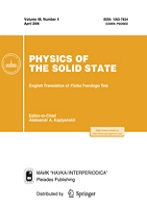|
This article is cited in 3 scientific papers (total in 3 papers)
Low dimensional systems
Comparative X-ray absorption analysis of the spectrum of vacant electronic states in cobalt and nickel tetraphenylporphyrin complexes
G. I. Svirskiya, A. V. Generalovab, A. Yu. Klyushinacd, K. A. Simonovaeb, S. A. Krasnikovaf, N. A. Vinogradovab, A. L. Trigubg, Ya. V. Zubavichusg, A. B. Preobrazhenskiba, A. S. Vinogradova
a Saint Petersburg State University
b MAX IV Laboratory, University of Lund, PO Box 118, Lund, Sweden
c Research Group Catalysis for Energy, Helmholtz Zentrum Berlin,
Berlin, Germany
d Fritz-Haber-Institut der Max-Planck-Gesellschaft, Dept. Inorganic Chemistry, Berlin, Germany
e Uppsala University, Department of Physics and Astronomy, Uppsala, Sweden
f School of Physical Sciences, Dublin City University, Dublin, Republic of Ireland
g National Research Centre "Kurchatov Institute", Moscow
Abstract:
The energy distributions and the properties of the lower vacant electronic states in cobalt and nickel tetraphenylporphyrin complexes CoTPP and NiTPP are studied by X-ray absorption spectroscopy. Quasimolecular analysis of the experimental absorption spectra measured in the region of the 2 p and 1 s ionization thresholds of complexing metal atoms, as well as the 1 s thresholds of ligand atoms (nitrogen and carbon), is based on the comparison of the corresponding spectra with each other and with the spectra of the simplest nickel porphyrin NiP. It has been established that, despite a general similarity of the spectra of nitrogen and carbon in CoTPP and NiTPP, the fine structure of the 2 p and 1 s absorption spectra of cobalt and nickel atoms are radically different. The observed differences in the spectra of cobalt and nickel are associated with the features of the energy distribution of vacant 3 d electron states. The presence in CoTPP of the partially filled valence
3db2g molecular orbital (MO) results in the appearance in the cobalt spectra of a low-energy band, which is absent in the spectrum of nickel in NiTPP and leads to a doublet structure of transitions to b1g and eg MOs due to the exchange interaction between 3 d electrons in partially filled 3db2g and 3db1g or 3deg МОs. The spectrum of vacant states in CoTPP differs from that in NiTPP also due to the smaller energy distance between 3db1g-МО and eg MOs and the different positions of nonbonding MOs with the C2 p character of the porphine ligand.
Received: 03.07.2017
Citation:
G. I. Svirskiy, A. V. Generalov, A. Yu. Klyushin, K. A. Simonov, S. A. Krasnikov, N. A. Vinogradov, A. L. Trigub, Ya. V. Zubavichus, A. B. Preobrazhenski, A. S. Vinogradov, “Comparative X-ray absorption analysis of the spectrum of vacant electronic states in cobalt and nickel tetraphenylporphyrin complexes”, Fizika Tverdogo Tela, 60:3 (2018), 574–584; Phys. Solid State, 60:3 (2018), 581–591
Linking options:
https://www.mathnet.ru/eng/ftt9281 https://www.mathnet.ru/eng/ftt/v60/i3/p574
|


| Statistics & downloads: |
| Abstract page: | 69 | | Full-text PDF : | 11 |
|



 Contact us:
Contact us: Terms of Use
Terms of Use
 Registration to the website
Registration to the website Logotypes
Logotypes